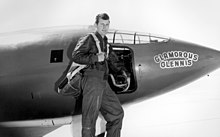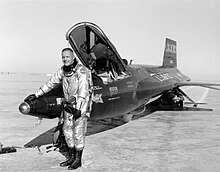Test pilot
This article includes a list of general references, but it lacks sufficient corresponding inline citations. (April 2009) |



A test pilot is an aircraft pilot with additional training to fly and evaluate experimental, newly produced and modified aircraft with specific maneuvers, known as flight test techniques.[2]
History
Test flying as a systematic activity started during the First World War, at the Royal Aircraft Establishment (RAE) in the United Kingdom. An "Experimental Flight" was formed at the Central Flying School. During the 1920s, test flying was further developed by the RAE in the UK, and by the
At the insistence of President
The world's oldest test pilot school is what is now called the
Qualifications
- Understand a test plan
- Stick to a test plan by flying a plane in a highly specific way
- Carefully document the results of each test
- Have an excellent feel for the aircraft and sense exactly how it is behaving oddly if it is doing so
- Solve problems quickly if anything goes wrong with the aircraft during a test
- Cope with many different things going wrong at once
- Effectively communicate flight test observations to engineers and relate engineering results to the pilot community, thus bridging the gap between those who design and build aircraft with those who employ the aircraft to accomplish a mission
- Have an excellent knowledge of aeronautical engineeringto understand how and why planes are tested.
- Be above-average pilots with excellent analytical skillsand the ability to fly accurately while they follow a flight plan.
Test pilots can be experimental and engineering test pilots (investigating the characteristics of new types of aircraft during development) or production test pilots (the more mundane role of confirming the characteristics of new aircraft as they come off the production line). Many test pilots would perform both roles during their careers. Modern test pilots often receive formal training from highly-selective military test pilot schools, but other test pilots receive training and experience from civilian institutions and/or manufacturers' test pilot development programs (see list of test pilot schools).
Notable test pilots (partial list)
- Milburn Apt, first U.S. Air Force test pilot to fly faster than Mach 3
- Eric "Winkle" Brown, flew more aircraft types than any other pilot
- Scott Crossfield, chief test pilot at North American Engineering
- David P. Davies, chief test pilot for the UK Civil Aviation Authority
- Tony LeVier, chief engineering test pilot at Lockheed Corporation
- Chuck Yeager, first pilot to break the sound barrier in level flight
- Fernando Alonso, former Head of Airbus Flight Test
- Hanna Reitsch, WWII German aviator and test pilot
- 'Mutt' Summers, first to fly the Supermarine Spitfire
- air racerand author
- Aleksandr Fedotov, first Soviet pilot to reach Mach 3
- Su-27
- Viktor Pugachev, first public performer of the Cobra maneuver
- MiG-29
- André Turcat, French test pilot and first to fly the Concorde
- Brian Trubshaw, first British pilot to fly the Concorde
- cosmonautand politician
- Toktar Aubakirov, Soviet test pilot first Kazakh in space
- Geoffrey de Havilland, first to fly the Mosquito
- MiG-29OVT
See also
- List of aerospace flight test centres
- The Right Stuff by Tom Wolfe
References
Notes
- ^ Léon Lemartin (Ai. 1899)
- ^ Stinton, Darrol. Flying Qualities and Flight Testing of the Airplane. American Institute of Aeronautics and Astronautics, Inc., 1996, p. 265
- ^ Знаменская, Наталья, ed. (2002). ШЛИ со временем [ShLI in Time] (in Russian) (2 ed.). Жуковский: ООО "Редакция газеты "Жуковские вести". p. 400.
Bibliography
- Hallion, Richard P.Test Pilots: Frontiersmen of Flight. Washington, DC: Smithsonian Press, 1988. ISBN 978-0874745498
- Warsitz, Lutz: THE FIRST JET PILOT – The Story of German Test Pilot Erich Warsitz, Pen and Sword Books Ltd., England, 2009, ISBN 978-1-84415-818-8
External links
- The Society of Experimental Test Pilots
- Society of Flight Test Engineers
- Wilson, George C. Flying the edge: the making of Navy test pilots. Naval Institute Press, 1992. ISBN 1557509255.
- Memorial website for test pilots who died in flying accidents in the UK
- Flight list of display and test pilots at 1957 Farnborough air show
- The Scott Crossfield Foundation
- Website on Erich Warsitz (world's first jet pilot)
